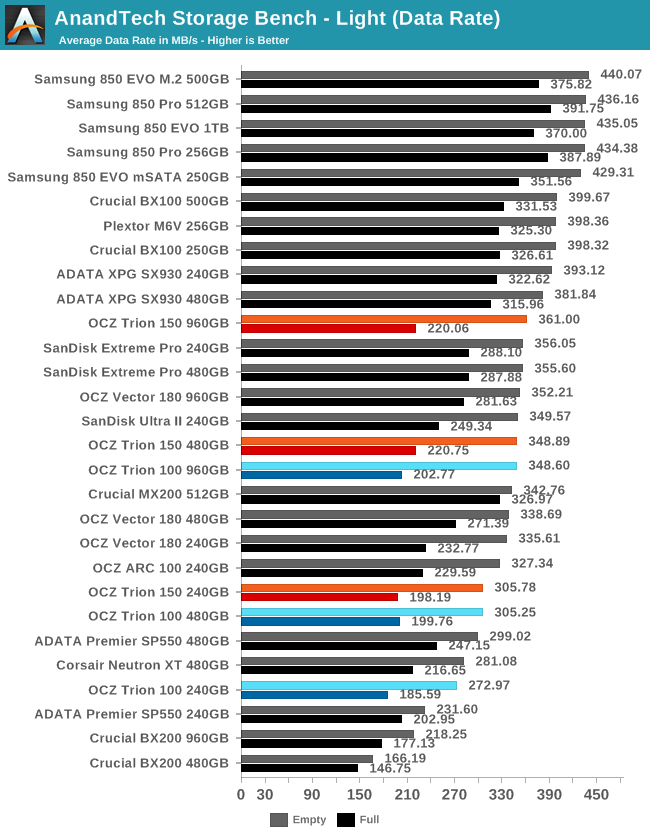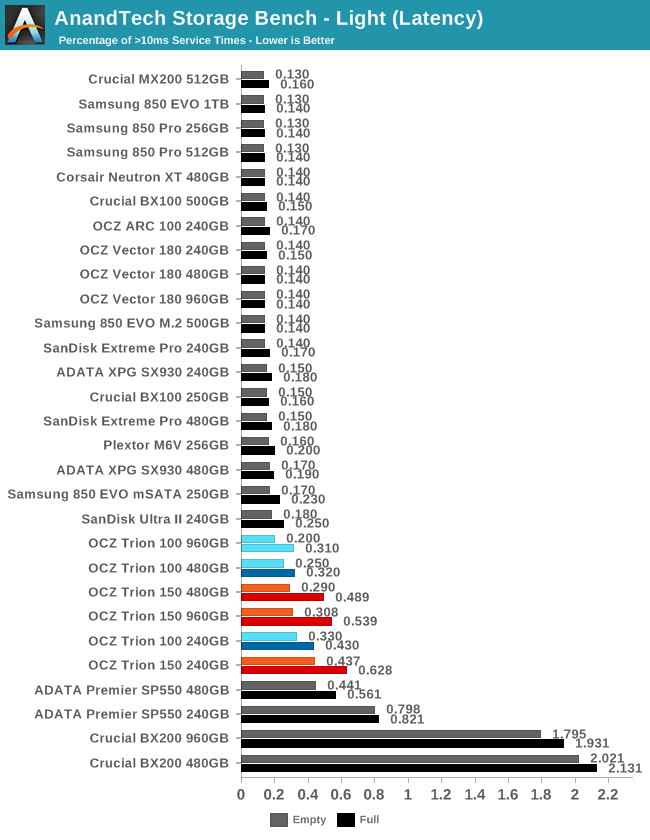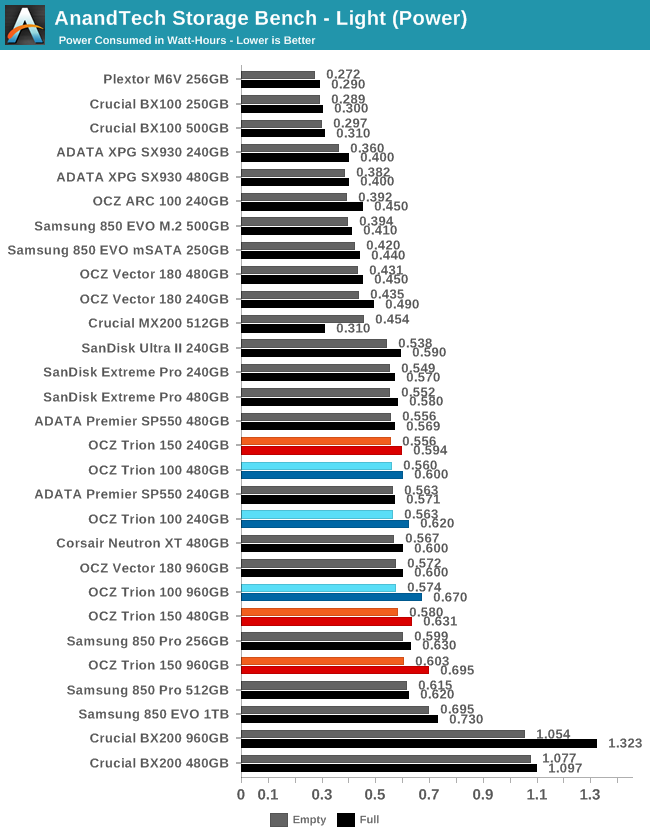The OCZ Trion 150 SSD Review
by Billy Tallis on April 1, 2016 8:00 AM ESTAnandTech Storage Bench - Light
Our Light storage test has relatively more sequential accesses and lower queue depths than The Destroyer or the Heavy test, and it's by far the shortest test overall. It's based largely on applications that aren't highly dependent on storage performance, so this is a test more of application launch times and file load times. This test can be seen as the sum of all the little delays in daily usage, but with the idle times trimmed to 25ms it takes less than half an hour to run. Details of the Light test can be found here.

On the Light test, each Trion 150 manages a slightly higher average data rate than the Trion 100 of twice the capacity. The Trion 100 and 150 continue to show the largest discrepancies in performance when the test is run on a full drive instead of an empty drive.

Average service times have regressed slightly from the Trion 100 to the Trion 150, but the results are all still reasonable, especially for a budget drive.

The latency regression and full-drive penalty both show up more clearly when looking at the number of high-latency outliers than when comparing average service time.

Power consumption on the Light test has not changed meaningfully and the Trion 150's energy usage is perfectly normal.










79 Comments
View All Comments
RBFL - Saturday, April 2, 2016 - link
What do you define as decent priced?xrror - Saturday, April 2, 2016 - link
The worst part I'm guessing is finding anything decently priced that isn't 1366x768. I hate that resolution so much. My keep looking to replace my old core2 craptop that wheezes along (sadly it uses the most gimped/market segmented version of the Intel 945GM chipset), But it uses an old school 1440x900 screen - and that vertical space I refuse to give up.Sorry folks, when I see 768 - that was only cool back when 1024x768 was an upgrade from VGA's 800x600. F going back.
Samus - Sunday, April 3, 2016 - link
Look at HP Elitebooks like the 820 and 840, they come standard with 1600x900 screens (which is a perfect resolution on the 12.5" 820.1920x1080 is fine and all on a 14"+ but really sucks on a 11-13" unless you have display scaling. Windows 7 and Linux it just sucks unless you have eagle vision.
BurntMyBacon - Monday, April 4, 2016 - link
@Samus: "Look at HP Elitebooks like the 820 and 840, they come standard with 1600x900 screens (which is a perfect resolution on the 12.5" 820."I do rather like that resolution for this size on a notebook. Tablets are generally used at a closer distance, but I digress.
@Samus: "1920x1080 is fine and all on a 14"+ but really sucks on a 11-13" unless you have display scaling. Windows 7 and Linux it just sucks unless you have eagle vision."
Yet I'd still rather see 1920x1080 than 1366x768 as I find it less frustrating to lean a little closer when I need to than to not be able to get the content I want on screen. Until better scaling is commonplace, 1680x1050 or 1600x900 please.
Arbie - Friday, April 1, 2016 - link
The link below is a 2011 review on Anandtech, showing Velociraptor scores vs SSDs of the time. You can estimate pretty well from that how things would compare now.FYI, the Mushkin Reactor 1TB MLC SSD (reviewed here recently) is available for $220 on NeweggBusiness.
http://www.anandtech.com/show/4337/z68-ssd-caching...
Samus - Sunday, April 3, 2016 - link
Excellent drive (the Mushkin Reactor) I have recommended it at least a dozen times and never heard a complaint. Stark contrast to the one person who didn't take my advice (I have two of them so I know how good they are) and bought the Sandisk Ultra II 960GB instead because it was $20 cheaper. It failed on them after 4 months. Which is alarmingly common if you read the reviews on Newegg.Ryan Smith - Friday, April 1, 2016 - link
"Second, would it be at all reasonable to add a WD VelociRaptor, Hybrid SSHD, and/or common 5400RPM hard drive to the 2015 SSD Bench like the old days?"It's definitely something we can look into. Keep in mind that we'd only be able to use them for a portion of the tests though; even a 7200 RPM drive would be impossibly slow on tests like the Destroyer that involve a lot of random activity.
BurntMyBacon - Monday, April 4, 2016 - link
@Ryan Smith: "It's definitely something we can look into. Keep in mind that we'd only be able to use them for a portion of the tests though; even a 7200 RPM drive would be impossibly slow on tests like the Destroyer that involve a lot of random activity."That is fine. The destroyer was made to tease out differences in performance and consistency between SSDs that are so high end that are hidden in lesser tests. One of your other (far less strenuous) tests is good enough as a reference point to show how HDDs stack with respect to random activity.
jsntech - Friday, April 1, 2016 - link
From a strictly business point of view, Toshiba should probably re-brand OCZ to some other name. Not a single member of my moderate circle of pro or power user friends will ever touch anything with OCZ in the name again. And they all told their friends, and they all told their friends, etc.Flunk - Friday, April 1, 2016 - link
I'd personally be happier with "Toshiba".